Most local residents have probably marveled at Thomas von Koch’s glasswork—and may even own one of his graceful, color-infused, nature-inspired creations—without realizing that the world-renowned artist has lived and worked right here in Southern Chester County since 2007. Von Koch’s work is widely available at retail outlets around the region and the country, including the Longwood Gardens gift shop, but his WGK Glass Art Studio remains a hidden gem tucked away on a former duPont estate in the green fields of Toughkenamon near New Garden Airport.
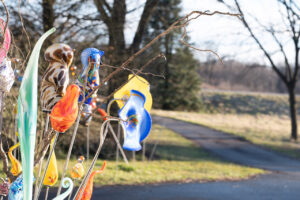
Colorful glass-blown flowers welcome visitors to WGK Glass Art on Newark Road in Toughkenamon.
First in his native Germany, then in a Landenberg studio, and now in his studios, gallery, and shop in Toughkenamon, von Koch has been working magic, blowing glass to breathe life into everything from tiny hummingbirds to fanciful dragons.
Kimya Williams, WGK Office and Accounts Manager and von Koch’s longtime right-hand associate, says his trademark style can be seen in the delicate details of his creations. Collectors know his work; novices perceive its beauty and detect instinctually what makes it unique. “Thomas’s style is inherent in the tilt of a wing tip, pointy but not sharp, a certain flair, the vibrant colors for which he’s known,” Williams says. Though his style has continued to evolve, von Koch’s magical, intricate dragons and hummingbirds, which are now also designed and created by WGK’s talented head lampworker Sandra Jahn, remain some of WGK’s most popular products.

The light and airy gallery at WGK Glass Art is filled with beautiful artisan-made creations.
Von Koch apprenticed to learn the glassblowing trade as a young man and in 1982, at age 25, he started his own business. Wertheim Glaskunst (WGK) is named after his hometown. He began by creating functional pieces including vases and wine glasses. As his skills developed and his creativity burgeoned, von Koch’s creations reflected more and more his passion to share his love and respect for nature, which grew out of many childhood summers spent in a small cottage in Austria. With a team of like-minded colleagues John Zinner, Sandra Jahn, and Anja Stötzer, von Koch continued to research and experiment and create—and a global audience for their work grew.
Having built up a customer base in the US, when the German economy deteriorated in the 1990s it made sense for the WGK team to come here, as self-described “economic refugees.” Southern Chester County, with its green open spaces, reminded von Koch of home, and he set out to make a living doing what he loved here.

Thomas von Koch with his longtime right-hand associate, Office and Accounts Manager Kimya Williams.
Two techniques, infinite possibilities
The two studios at WGK are each set up for a different kind of glasswork, Williams explains. In the lampwork studio, head lampworker Jahn can often be found performing astounding feats of alchemy. Lampwork (also called torchwork or flamework) involves melting glass rods on a tabletop with the flame from a burner or torch and transforming the honey-like substance into new creations.
The flying strands of glass are notoriously difficult to balance and maneuver, and doing so—twisting rods in different directions and making infinite minute adjustments at the speed of light—requires ambidexterity and years of practice. “It’s like drawing in the air with a moving object,” Williams says, and she’s in awe of Jahn’s talent and expertise. Unique products from the WGK lampwork studio include birds in flight, undulating mermaids, diaphanous double-headed dragons, and even tiny, delicate earrings.
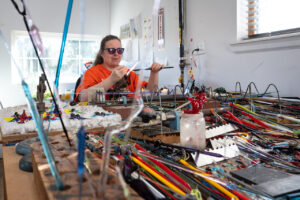
In WGK’s lampwork studio, head lampworker Sandra Jahn spins melted glass into magical creations including birds in flight, undulating mermaids, and diaphanous double-headed dragons.
In the furnace studio, WGK artisans perform equally magical feats, gathering glass on long metal pipes and twisting and working the glass in the furnace to create everything from delicate pumpkins to bouquets of flowers and stunning and durable garden sculptures.
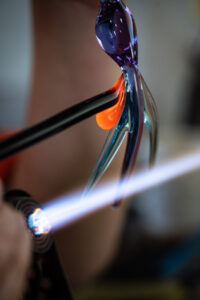
While master lampworkers like Jahn make it look effortless, Williams describes the process of shaping the honey-like glass as being “like drawing in the air with a moving object.”
WGK’s popular workshops, where participants are taught to create objects including a heart, flower, pumpkin, or Easter egg, are all conducted in the furnace studio. The furnace is kept at 3,000 degrees, but since glass doesn’t conduct heat the long metal tubes keep those working with the glass at a safe distance. Like lampwork, glassblowing also takes years to master and to, in Williams’ words, “get your idea into the glass.”
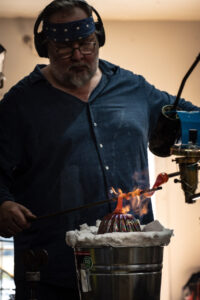
In the furnace studio, WGK artisans gather glass on long metal pipes and twist and work the glass to create everything from pumpkins with delicate tendrils to durable garden sculptures.
While hard, or boro (borosilicate), glass is used to create functional pieces like vases and glassware, WGK artists use soft glass, in an array of vibrant colors, imported from Germany and the Czech Republic. Soft glass melts more quickly and has a higher COE (coefficient of expansion), which means it can be manipulated and shaped at a lower temperature.

Kimya Williams was von Koch’s customs clearance agent at BAX Global for years before coming on board with WGK Glass Art to help manage, promote, and support the growing business.
Creativity and coordination
Off-the-charts creativity has always been one of von Koch’s trademarks. “He’s so inventive and creative in many different ways,” Williams says. She laughs as she describes his setup at early shows. “Everyone else had arranged tables, and Thomas had mannequins coming out of the wall!” Von Koch was a pioneer in the US market, creating designs from mythology and nature. As his business grew, he realized he needed someone to help coordinate and bring it to the next level.
Kimya Williams is a Georgia native whose first name means “silent” in Swahili. She moved north when she was 18 and met von Koch while working for BAX Global, an international shipping company, at Philadelphia airport. “I was his customs clearance agent for all of the glass rods and materials he imported,” she says. “We worked together for years and built up a great relationship.” When she was laid off in 2009, von Koch asked her to join his team.
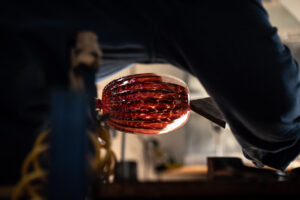
A glass art pumpkin is born in the furnace studio at WGK Glass Art.
“I didn’t know anything about glass blowing,” Williams says, “but at the time he was a one-man band managing his own business. What he needed was someone who knew customer service, finance, communications, promotion—and lots of organization. I came in so he could be the artist he wanted to be.” Williams, who is exactly the kind of consummate promoter and supporter every artist needs, performs intricate logistical balancing acts of her own, running an international business while also creating opportunities to connect with the local community.
While von Koch is not as often at the bench these days, he continues to design and bring his passionately creative ideas to life through the artisans he has nurtured and trained. Von Koch and Jahn regularly exchange spirited opinions about new designs. Williams hears it all, picking up the odd word of German, knowing that the result of their collaboration will be beautiful and unique. Sometimes she gives her opinion or, in the case of the green Philadelphia Eagle with a football in its talons, she comes up with a great new idea.
Von Koch and Jahn are also passionate about passing on traditional German glassblowing techniques. Williams gives the example of Calvin, a talented young apprentice at WGK being taught by Jahn, and she emphasizes the importance of the mentoring relationship for someone who wants to learn. “It’s a bit like Plato and Socrates,” she says. “Thomas and Sandra are both very open, welcoming, and generous people, passing on what they’ve learned of their craft.”
Von Koch’s insatiable curiosity about the world and love for nature, his delight in color and form, and his deep knowledge of the art and science of glassblowing can all be seen in the studio’s creations. “It’s a joy to watch him, and all of the artisans here, create,” Williams says.

Workshop participants have the opportunity to try their hand at creating their own glass-blown pumpkin, flower, heart, or Easter egg.
Cultivating community
Exhibiting at trade and retail shows around the country over the years enabled von Koch to deepen and broaden his customer base. Opening an Etsy shop and being at shows closer to home like the Philadelphia Flower Show helped build their retail sales. As the time- and labor-intensive travel, setup, and tear down took their toll, von Koch began to dream about the possibilities of setting up a studio and gallery with a retail shop and space for workshops. In particular, he wondered about the property on Newark Road that he and Williams passed regularly en route to and from shows like the Philadelphia Flower Show and others. He inquired about it in 2013—and it was for sale.
The gallery and studio have been officially open to the public since 2020, and the WGK team has been working to find creative ways to engage and support the local community. In addition to being fun and creative, their glassblowing workshops, which are open to participants age 14 and up, teach traditional techniques and help to cultivate an appreciation for German art and culture and artisan-crafted goods.

Von Koch and his team welcome visitors to the gallery and studio, open every day at 1255 Newark Road in Toughkenamon.
WGK’s first annual Glass Pumpkin Festival in September featured local beer, wine, food, a marketplace, and live music—and the warm embrace of a creative gathering fueled by community spirit. The WGK team is already looking forward to the next pumpkin festival, which will be held September 15–17. “Everyone will go home with a glass piece,” Williams says. “It’s a great introduction for children to see these beautiful pieces and hold them in their hands. Lots of people need to feel the glass to connect with it.” The studio is taking pre-registrations for their May “Make Your Own Glass Flower” workshops.
WGK Glass Art gallery and studio, located at 1255 Newark Road in Toughkenamon, is open Monday through Friday from 9am to 5pm, on Saturdays from 9:30am to 5pm, and 12pm to 5pm on Sundays.
Find the online WGK Glass Art shop here, follow them on Facebook and Instagram, and subscribe to the WGK YouTube channel here.
Photos by Dylan Francis.





